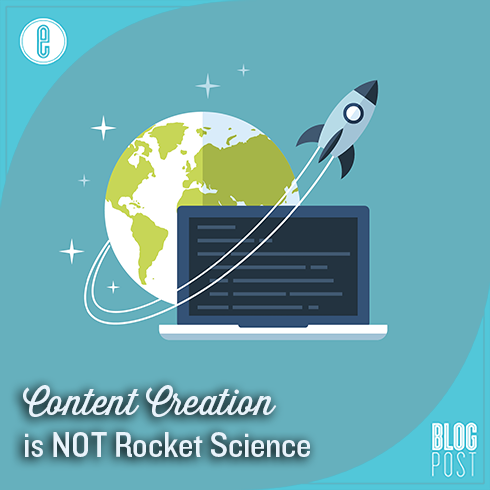So you don’t have a content strategy? Don’t panic. Yes, your business needs one, but if you’re in business at all, you probably do have a content creation strategy – you just don’t realize it.
Discovering Your Content Strategy
In everything you know about your customer base, your business’s seasonal fluctuations, industry trends, and your standard operating procedures, there exists a wealth of content.
Sorting through it will take some time; spinning it into useful, educational content for your prospects will take more time. But this isn’t rocket science – unless of course your business is rocket science. In which case – well, actually, the same strategy applies!
Assuming your business is rocket science, let’s look at how you could start crafting your content.
Where you’ll find great content:
Your company’s history
Did you fall in love with rocket science when you got a toy airplane on your third birthday? There’s a blog post in that story. Did you fail miserably at your science fair project, which kindled a life-long “do-it-better” philosophy? That may be the basis for your mission statement – and a blog post entitled “The Story Behind our Mission Statement.”
Your best customers
Study your best customers. Why do they do business with you? What do they tell their friends about your company? These are practically ready-made tweets. (“I love that you take appointments online,” said one of our customers today. “I was on Mars when my rocket’s check-engine light came on. I just emailed to let you know I needed a service appointment, and you were ready when I got there!”)
Seasonal stuff
This really isn’t rocket science – except in our hypothetical example. If spring is your busy season for boosters, tweet ahead of the season to tell customers and prospects you’re ready to help them get ready for their busy season. Tell them about your expanded business hours. Or offer a discount on pre-season service.
Industry News & Trends
When the astronaut training committee changes its rules to increase the number of required in-flight training hours for certification, it may not directly affect the booster business, but your customers will be interested. When entertainment companies are dropping their prices on satellite TV service to rockets, you can bet your customers will want to read about it – and your take on it. After all, you’re the industry insider.
Standard Operating Procedures
So how can your standard operating procedures turn into captivating blog posts? Think customer education. Your life will be easier if your customers know how to fill out a finance application for turbo-charged boosters and accessories. Help your customers understand customization options before they buy – they’ll be happier knowing how to select the racing stripes and cupholders they want. Go to your SOP manual and look at each page, thinking, “how would I explain this to a customer or prospect?” The answer just might be your next blog post.
Organize What You’ve Discovered
A content strategy uses many different types of content, from short and pithy tweets to in-depth, how-to ebooks. Review the list of content-rich information you’ve discovered and identify which pieces will work best where. (Hint: it can all be re-tooled and then, re-purposed in another channel.)
To have a strategy, you have to identify where your content belongs, in what form, and when it should be published. In other words, you’ll need to get organized. A thousand tools exist to help – but at the most basic, you’ll need a spreadsheet and a calendar.
Of course, if your business is rocket science, you’ll probably want a higher-tech solution.
Content for People Who Hate To Write
While you’ll use a variety of different content in different channels, most of your pieces won’t be very long. You’re not writing a book! Just one word at a time.
As you can see in the examples above, a long story (about the history of your company, for example) can be the basis for an e-book, a long blog post, and links to those posts on Twitter and Facebook. That’s what’s cool about a content strategy – once you’ve started looking at the content around you, you’ll start to see many ways to use it.
It’s not rocket science, but once you’ve identified your content creation strategy, you’ll see your customer engagement soar.
-FINAL(01-00)-White&Blue-01.svg)





